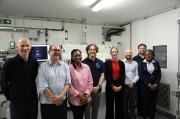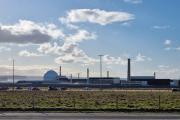Dounreay Bulletin - Issue 20
13th February 2007

DOUNREAY DIRECTOR NAMED AS NEW CHIEF EXECUTIVE
Norman Harrison, currently acting chief operating officer of UKAEA, has been appointed its chief executive officer.
A chemist by profession, he was appointed director of Dounreay in 2003. He transformed the Dounreay site into a projectfocussed organisation, integrating expert staff from UKAEA's alliance partners CH2M Hill and AMEC into the site's management team, embedding improvements in safety culture, and establishing Dounreay as one of the highest performing sites in the Nuclear Decommissioning Authority's portfolio. He became acting chief operating officer of UKAEA in August 2006, since when his deputy at Dounreay, Simon Middlemas, has been acting site director.
"With his strong operational experience and excellent safety record, he is the right person at the right time to lead UKAEA as it restructures its operations to prepare for the competition of its nuclear sites and the development of its business activities. Everyone who knows Norman respects his integrity and dedication. His appointment will be widely welcomed by all our stakeholders, and by UKAEA staff," said UKAEA chairwoman Barbara Thomas Judge. See: http://www.ukaea.org.uk/news/Press_Release_Archive_2007.htm
PARTICLES COURT CASE MEANS ATTENTION CAN NOW FOCUS ON CLEAN-UP
UKAEA pleaded guilty at Wick Sheriff Court on February 5 to four charges under the Radioactive Substances Act 1960. The charges related to the unauthorised disposal of radioactive waste to a landfill site at Dounreay between 1963 and 1975, and the release of particles from the site to the environment on dates between 1963 and 1984. Sentence was deferred until February 15.
Speaking outside the court following the case, UKAEA Director of Safety Dr John Crofts said: "UKAEA deeply regrets that some particles were released from the site. Our priority today is to rectify those errors and minimising their impact on the environment. The practices which gave rise to these particles ceased long ago and we are now focussed on our mission to remediate the site and deal with the particles issue.
"We are working very closely with SEPA and others, in particular the affected adjoining estate and our new business partners AMEC and CH2MHILL, to deliver innovative clean-up solutions to these legacies and ensure that current and future generations do not have to live with unacceptable risks inherited from yesterday's practices." See: http://www.ukaea.org.uk/news/2007/07-02-07.html
SEPA chief executive Campbell Gemmell said: "UKAEA has cleaned-up its act significantly and is making strenuous efforts to safely dismantle the Dounreay site, which is no easy job. As part of our commitment to better regulation we will support them in doing this, as we support other operators who are serious about the environment. However, we are still the 'watchdog' on behalf of the public. I sincerely hope that we do not need to use our powers again, but we will do so if that is necessary." See: http://www.sepa.org.uk/news/releases/view.asp?id=490&y=2007
DOUNREAY ADAPTS CLEAN-UP TECHNIQUES FROM AVIATION INDUSTRY
Dounreay has taken advantage of innovative technology used by the commercial aviation industry to help clean up a contaminated criticality cell in a former plutonium criticality building now being taken apart. The contamination was ingrained into the metal structure and had been painted over many years ago after unsuccessful attempts to remove it. The project team decided that the best way to clean off the contamination was to use sponge blasting, a clean, dry abrasive blasting technology used in many industries. A major use of sponge blasting is to remove paint from aircraft before repainting, as it does not damage sensitive surfaces. See: http://www.ukaea.org.uk/sites/dounreay_project_updates.htm
DOUNREAY LIQUID METAL CLEAN-UP PLANT SETS TO WORK
Removal of the radiologically-contaminated sodium-potassium (NaK) liquid metal coolant from the Dounreay Fast Reactor is a key part of the site decommissioning programme. In preparation for removing the redundant coolant from the reactor, a purpose-built destruction plant has completed processing reactor-grade NaK as part of the inactive commissioning process. This modern plant is designed to safely destroy the heavily contaminated radioactive coolant using a proven method of dissolution, transforming the highly reactive metal into sodium/potassium nitrate and water that can then be cleaned up. The water can be discharged safely as low-active effluent in accordance with the site disposal authorisation. Once the DFR coolant has been removed it paves the way to start removing the 977 breeder elements, followed by dismantling and emptying the fifty-year old reactor block housed within the famous dome.
DFR FIRST FOR SAFETY
The safety conscious team decommissioning Dounreay's Fast Reactor has introduced a new state of the art communication system for its crane drivers, which replaces the need for hand-held radio devices. The simple but extremely effective system is built into a hard hat on a mounted set of ear defenders. This allows the drivers to communicate hands-free, allowing them to maintain full control of the complex crane equipment during operation, whilst continuing to maintain two-way contact with the essential safety support personnel such as the banksmen. The ear defenders still protect the operator's ears from outside noise, with the sound levels set to a safe limit.
The DFR team has achieved well over four years without a lost time accident and initiatives such as this play an important part in achieving such a commendable safety record. The new system has been successfully trialled by the crane operators and will be rolled out to other decommissioning tasks carried out at the site.
GROUP CONSIDERS FUTURE CONDITION OF DOUNREAY SITE
Dounreay Stakeholder Group is to hold a special meeting to consider public responses to a recent consultation about the condition that Dounreay should be left in once decommissioning is complete. The group, which was asked by the Nuclear Decommissioning Authority to canvas opinion on options, will hold the meeting at 6pm on February 15 at the Royal Hotel, Thurso. The meeting is open to members of the public to attend. Earlier, there will be a drop-in session for members of the public between 2pm and 4pm. A recommendation is due to be made to the NDA by the end of March. On January 29, UKAEA's Doug Graham addressed a meeting of the Caithness area committee of Highland Council about the options. Decommissioning is currently due for completion by 2033. See: www.dounreaystakeholdergroup.org/admin/documents/index.php
UKAEA SEEKS PERMISSION TO DEMOLISH VIEWFIRTH PROPERTY
UKAEA has applied to Highland Council for a warrant to proceed with the demolition of the former Dounreay Sports and Social Club at Viewfirth, Thurso. The property has been vacant since the demise of the club a year. It is structurally unsound and has become a target for vandalism. UKAEA and NDA have invited local organisations to come up with a proposal to redevelop the site under community ownership.
PFR SCRAP METAL HELPS LOCAL TRIALS FACILITY
Scrap metal from the strip-out of the Prototype Fast Reactor (PFR) secondary sodium circuit cells is being re-used by UKAEA at the T3uk purpose-built trials centre at Janetstown on the outskirts of Thurso. The redundant steel sections, once used to support pipework within the cells, were identified for re-use to assist with other Dounreay decommissioning projects. See: http://www.ukaea.org.uk/sites/dounreay_project_updates.htm#Feb0704
EMPLOYEE OPINIONS MATTER
As UKAEA and sites such as Dounreay move increasingly into a new commercial environment, an employee opinion survey is to be carried out across all five sites currently managed by UKAEA to obtain feedback on a range of issues in an attempt to improve communications. Questionnaires will be issued to all UKAEA staff within the next few weeks and will be analysed quickly by senior management, who will address any issues raised and implement new initiatives as required.
A BOOST TO CAITHNESS COACHING
NUKEM at Dounreay has increased its support for sports coaching in Caithness by handing over a cheque for �2000 to the local sports council, which provides grant-aid to groups in the area. See: http://www.nukem.co.uk/news_and_events/recent_news/story/?id=35
Related Businesses
Related Articles
UKAEA develops 3D printing for fusion components
At its recently opened Central Support Facility (CSF), UKAEA has commissioned an electron beam additive manufacturing machine that can be used to incorporate tungsten into components, alongside a selective laser manufacturing machine. Fusion can play a key role in a global low carbon energy future.Advancing Fusion Remote Maintenance: Industry Collaboration Driving Innovation
As part of the Fusion Futures (FF) programme, UKAEA's Remote Applications in Challenging Environments (RACE) has partnered with industry leaders to develop two groundbreaking technologies for remote maintenance in fusion energy engineering. Thanks to FF funding, industry has taken the lead in maturing UKAEA technology concepts—delivering real-world solutions that enhance operational autonomy and reduce maintenance burdens in extreme environments.UKAEA launches International Fellowships Scheme for fusion
UKAEA has launched the International Fellowships Scheme, an initiative to help expand the global talent pool supporting the fusion industry. The scheme is part of the UKAEA's Fusion Opportunities in Skills, Training, Education and Research (FOSTER) Programme, which aims to train, support, and empower the next generation of professionals, who will help deliver fusion power to the grid.Kyoto Fusioneering and Astral Systems join Culham fusion hub
UKAEA's Culham Campus welcomes Kyoto Fusioneering and Astral Systems as its latest tenants. Two pioneering companies, Kyoto Fusioneering and Astral Systems, have joined the growing cluster of fusion technology and AI organisations at United Kingdom Atomic Energy Authority's (UKAEA) Culham Campus.
Fusion-grade Steel Produced At Scale In UK-first
Researchers achieve 10x production cost savings for reduced activation steel. A United Kingdom Atomic Energy Authority (UKAEA) working group has successfully demonstrated the industrial scale production of fusion-grade steel.
UKAEA To Lead The Creation Of A Robotics And AI Cluster
UKAEA will lead the creation of a new £4.9m nuclear robotics and artificial intelligence cluster across Cumbria and Oxfordshire. The robotics and AI cluster was announced by UK Research and Innovation (UKRI) as one of seven new projects to kickstart economic growth and address regional needs: www.ukri.org The robotics and AI cluster will link Cumbria and Oxfordshire to accelerate the decommissioning of the UK's legacy nuclear fission facilities and keep people out of hazardous environments.
Diamonds Are Forever? World-first Carbon-14 Diamond Battery Made In Uk
The world's first carbon-14 diamond has been produced with the potential to provide power for thousands of years. Scientists and engineers from the UK Atomic Energy Authority (UKAEA) and the University of Bristol have successfully created the world's first carbon-14 diamond battery.
UKAEA Monthly Newsletter Latest Edition
Find out what has been happening at UKAEA in our monthly newsletter. Read about our recent activities and upcoming events.
UKAEA Newsletter - Edition 11 Published Today
Find out what has been happening at UKAEA in our monthly newsletter. Read about our recent activities and upcoming events.
Corwm Visits Dounreay Nuclear Site
Members were given an overview of the scale of the problem and challenges faced in the decommissioning of the site. In the last week of March 2024, several members of CoRWM led by the Chair, Sir Nigel Thrift, made the long journey up to the North of Scotland to visit the Dounreay nuclear site, now managed by Nuclear Restoration Services.
